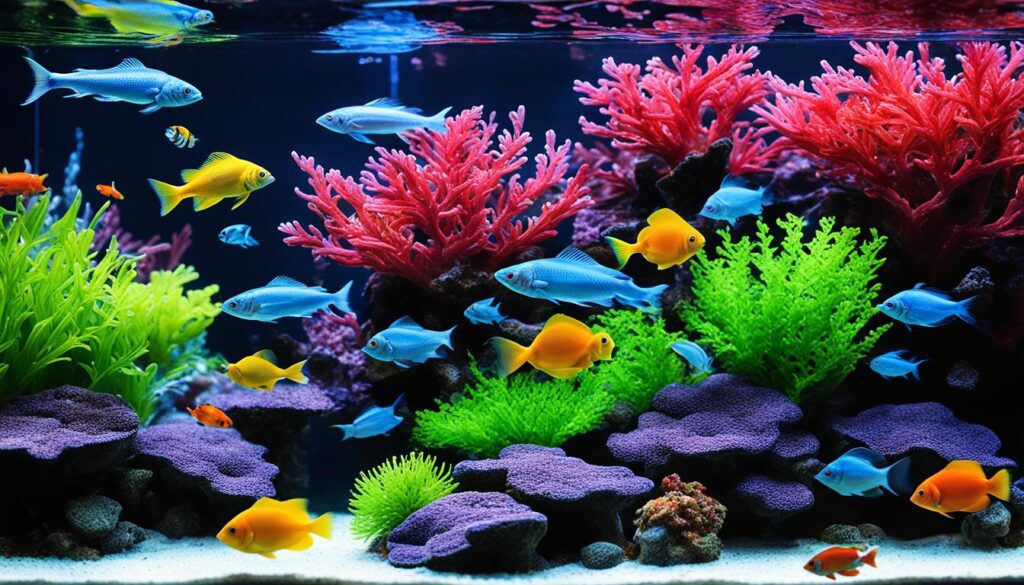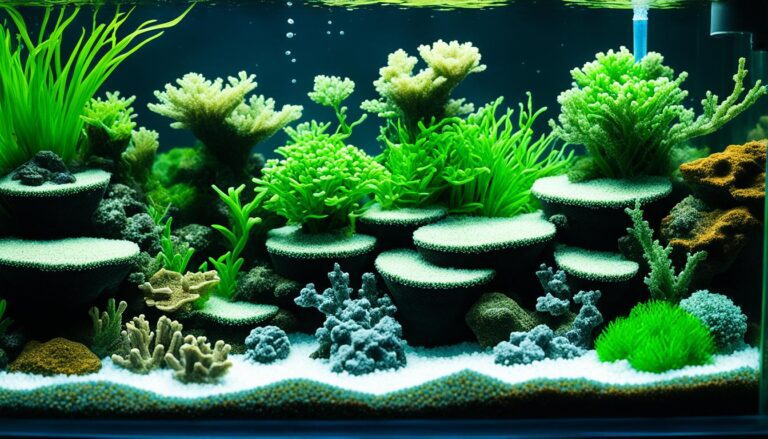As a keen aquarist, I always prioritize aquarium safety in my tank care routines. Ensuring the health of the aquatic ecosystem means having a good filtration system. The success of chemical filtration media in removing pollutants is well recognized.
I value the clear water and reduced smells that chemical filtration provides through toxin adsorption. But is this method safe for all aquarium types? We need to find the right balance between removing harmful substances and keeping the environment safe for fish and plants.
Understanding the Role of Chemical Filtration in Aquariums

Understanding chemical filtration is key for a healthy, beautiful aquarium. It removes dissolved contaminants, improves aquarium clarity, and reduces odor. Filters use materials like activated carbon, granular ferric oxide (GFO), or Purigen to clean the water. Each targets various pollutants, enhancing the water’s health and appearance.
Chemical filtration works by catching and neutralizing toxins, such as tannins and phenols. Activated carbon is great for removing odors and color, making water clear. GFO helps control algae by lowering phosphate and silicate levels. Purigen, on the other hand, makes water crystal-clear by removing organic waste.
Filtration Media |
Target Contaminant |
Replacement Frequency |
Primary Benefit |
|---|---|---|---|
Activated Carbon |
Organic waste, odors, discoloration |
1-2 months |
Improves clarity and smell |
Granular Ferric Oxide (GFO) |
Phosphates, silicates |
1-3 months |
Reduces algae growth |
Purigen |
Organic compounds |
As the media saturates |
Enhances water clarity |
To keep your filter working well, change the media when it’s full. If you don’t, the filter won’t clean the water properly. It’s important to do this to keep your tank not just looking good, but safe for your fish and plants.
Chemical filtration is vital for a healthy tank. Choose and replace your filter media wisely. This way, you’ll ensure your aquarium’s water stays clean. This is key for the well-being and lifespan of your tank’s inhabitants.
The Significance of Filtration Types for Aquarium Health

Maintaining an aquarium is more than feeding fish and water changes. It’s about understanding different filtration types. Each type plays a unique role in keeping the water clean and balanced. Let’s explore how these filtration methods help manage aquarium bioload and keep aquatic life healthy.
Mechanical Filration: The First Line of Defense
Mechanical filtration is key in removing physical debris. It uses sponges, foam, or filter pads. These materials catch excess food, decaying matter, and other particles.
The success of the filtration system starts here. It stops harmful substances from hurting biological filters. Keeping mechanical media clean, by cleaning or replacing it every 2-4 weeks, is vital. This keeps the system working well.
Biological Filtration: Sustaining the Nitrogen Cycle
Biological filtration is crucial for managing the load of an aquarium. It uses bacteria to turn ammonia into safer substances. This process is known as the nitrogen cycle. Materials like live rocks and ceramic rings give these bacteria a place to live. They help remove waste from the water efficiently.
If you’re setting up a new tank, it takes time for beneficial bacteria to grow. Keep an eye on the water and don’t add too many fish too fast. This helps the bacteria develop without being overwhelmed.
Filter Type |
Main Function |
Typical Maintenance |
|---|---|---|
Mechanical Filters |
Traps physical debris |
Clean/Replace every 2-4 weeks |
Biological Filters |
Processes ammonia and nurtures nitrifying bacteria |
Monitor but rarely replace |
Chemical Filters |
Removes dissolved wastes via chemical media |
Replace media as per guidelines |
The key to a healthy aquarium is balancing and maintaining mechanical and biological filtration. By managing these systems well, your aquatic environment will thrive. This ensures your aquarium stays beautiful and lasts a long time.
Is Chemical Filtration Safe for Delicate Aquatic Ecosystems?

The importance of chemical filtration safety goes beyond just keeping water clean. It aims to protect the long-term health of delicate aquatic habitats. Keeping balanced nutrient levels is vital, especially in sensitive areas like coral reefs. It helps ensure the survival of these ecosystems. Also, it’s very important to have a non-toxic environment. This is especially true for species that are easily affected by changes in water quality.
Activated carbon, a form of chemical filtration, is key in removing dangerous substances. Yet, it must be used carefully. If carbon filters get full, they can release the toxins back into the water. This can ruin the efforts to keep the habitat clean and safe. To avoid this, it’s critical to check and change the filters when needed.
For more info on chemical filtration and water ecosystems, check out this research on the effects of sunscreen on coastal and filtration.
Filtration Type |
Usage |
Main Function |
Impact on Nutrients |
|---|---|---|---|
Mechanical |
Regular in all tanks |
Traps physical debris |
None |
Chemical (Carbon) |
Selected based on need |
Adsorbs impurities |
Potential nutrient removal |
Biological |
Essential for all setups |
Breaks down waste via bacteria |
Supports nutrient cycles |
When considering filtration methods, chemical filtration is essential for targeted cleaning. However, combining it with mechanical and biological filters is best. This method keeps the environment safe for aquatic life by removing toxins but keeping good substances.
Different species and tanks have specific requirements. The goal is to maintain a healthy balance. This approach helps preserve delicate aquatic habitats and their ecosystems.
Maximizing Aquarium Safety with the Right Filtration Balance
I’ve dedicated countless hours adjusting the environment for my fish. Finding the right filtration method is key. Chemical filtration must be used carefully because the aquatic ecosystem is fragile. For instance, activated carbon is great for tackling specific water quality problems. It shouldn’t be used all the time.
When to Employ Chemical Filtration
Here’s a tip: only use chemical filtration when really needed. It’s like using medicine for specific health issues. Sometimes, activated carbon is needed to clear odors or fight toxin spikes. It’s crucial to follow filter media recommendations. This prevents harming the water. Selecting the right maintenance schedule for each tank part is often a trial and error.
Recognizing the Signs of Chemical Filter Media Exhaustion
I always watch for signs that the filter media is worn out. Once it’s full, it can’t clean the water anymore. Signs include odors coming back, cloudy water, or a drop in water quality. These signal it’s time for new filter media. Changing activated carbon or zeolite every few months is what I do, following manufacturer instructions. Cleaning the impeller monthly and using aquarium water for media cleaning keeps everything running smoothly.
Fish tank safety is crucial. Ignoring risks can have deadly consequences. Make sure to replace biological media regularly and keep UV bulbs working well. Remember to turn off filters during feeding. Take steps to avoid chemical exposure and ensure good ventilation. These actions make a difference. By carefully watching, maintaining, and improving, we get a healthy aquarium. The vibrant fish swimming around is our reward.








